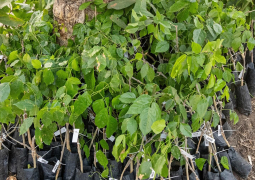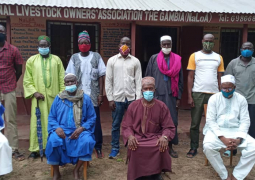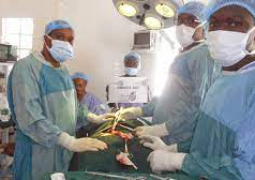
Exposure to extreme climate-related weather events increases the risk of forced migration, reduces access to good nutrition, education and employment, and threatens to jeopardize the physical and mental health of the world’s future adults.
Almost all of the current generation of 1.2 billion adolescents aged 10-19 are exposed to at least one climate and environmental hazard, shock or stress - heatwaves, cyclones, air pollution, flooding and water scarcity. Failure to avert a global rise in temperature of just 1.5°C will put their health and prospects for survival at extreme risk, delegates were told at a PMNCH-led side event at the 26th United Nations Climate Change Conference of the Parties (COP26) in Glasgow. Adolescents and youth bear no responsibility for the climate change emergency, yet they will face its harshest consequences if the world fails to rapidly reverse rising trends.
‘Building adolescents’ resilience to climate change’, hosted by PMNCH, the world’s largest alliance for women, children and adolescents’ health and well-being, was organized with the support of YOUNGO, the UNFCCC Youth Constituency, the International Federation of Medical Students (IFMSA) and Tremendas Collaborative Platform. The event aimed to draw attention to the importance of incorporating adolescent well-being into the COP26 Health Program, and in national climate adaptation policies and programs.
At 16% of the global total, the current adolescent population is the largest the world has ever known. More than one billion people under 18 live in countries at extremely high risk of climate change, meaning that their survival is significantly threatened.[i]
Climate change is a threat multiplier and the greatest hazard across all five domains of adolescents’ well-being: good health and optimum nutrition; connectedness, positive values, and contribution to society; safety and a supportive environment; learning, competence, education, skills, and employability; and agency and resilience.
Climate change affects children’s and adolescents’ physical health by increasing their risk of injury and lung disease, and susceptibility to infectious diseases and poor nutrition. It raises the risk of mortality and disability due to unintentional injury (the leading cause of death and disability among adolescents) caused by more extreme weather events. Girls are more likely to be killed during such disasters as they are often prevented from learning survival skills, such as swimming or climbing.[ii]
Rising temperatures, leading to worsening air quality, are increasing the incidence of asthma, the most common chronic disease in people under 18 worldwide.[iii] Global undernourishment rates have also risen amongst adolescents, in part, due to climate change and extreme weather events.[iv]
As well as adverse physical health outcomes, climate change is having an impact on adolescents’ and young people’s psychological well-being.
Adolescents are known to experience significant increases in rates of post-traumatic stress disorder, anxiety and depression following a climate related disaster.[v] These outcomes are major risk factors for suicide, the third leading cause of death in older adolescents aged 15-19. Some have developed ecoanxiety and climate anxiety, both of which specifically refer to the fears of future environmental disasters.[vi]
Climate-related extreme weather events often disrupt adolescents’ connectedness to family, friends and community, as well as threaten their safe and supportive environment through their effects on forced migration, interpersonal and collective conflict.
By creating economic shocks and natural resource scarcity, climate change can increase chances of conflict, both armed conflict and intimate partner violence, especially in already fragile humanitarian settings. This can lead to increased risks of sexual violence, malnutrition, and trauma. Girls are most at risk with evidence showing that extreme weather events, such as droughts, increase chances of child marriage, gender-based violence and teenage pregnancy, which is the main cause of maternal mortality and morbidity.[vii]
A high proportion of those displaced in the context of climate change disasters are young people. Around 40% of the 79.5 million forcibly displaced people in 2019 were under the age of 18.[viii] Even where no migration has occurred, climate-related extreme weather events may cause severe disruption to education, leading to school closures, destruction of school infrastructure and school dropouts due to families’ financial hardships. Girls are particularly disadvantaged and are also more likely to be removed from school during climate-related events.[ix]
“When these events occur, young women are more likely to drop out of school, be victim to sexual and physical violence when living in temporary shelters, and they disrupt access to reproductive health services that young women rely on,” said Natalie Mangondo, of Southern Africa Climate Finance Partnership, Zimbabwe.
Event speakers also emphasized that countries most vulnerable to climate change are often those in which there is a fragile humanitarian setting. Twenty-nine out of the thirty-three countries with extremely high risk to climate change are designated as fragile settings.[x] In such settings, adolescents and those who might be internally displaced, are most affected by climate change. Even within more stable countries, it is usually marginalized adolescents who bear the worst consequences of climate change.
“Climate change is a huge threat to adolescents’ well-being and safety, especially those from already vulnerable communities,” said Helen Clark, PMNCH Board Chair and former prime minister of New Zealand. “Extreme weather events increase the likelihood of forced migration and displacement, reduce access to good nutrition, education and employment, and severely affect physical and psychological health.
“At COP26 world leaders must step up their efforts to address the crisis, with sufficient commitment and resources. This includes engaging meaningfully with adolescents and youth in policy- and decision-making on climate resilient low carbon health systems.”
Emission reduction pledges made by countries ahead of COP26 are not enough to avert global temperatures rising beyond 1.5°C, which will inevitably lead to greater exposure to extreme weather events.
“At COP26, world leaders must recognize that climate change will have its greatest impact on the well-being of this and future generations of adolescents, and commit to do immediately everything in their power to respond to this rapidly deteriorating situation,” said David Imbago-Jácome, Chair, PMNCH Adolescents and Youth Constituency. “They must also recognise adolescents’ and young people’s right to play an active role in programming, monitoring, holding leaders accountable and deciding for themselves the appropriate remedies and actions that will protect their own well-being, and the well-being of their communities.”
To ensure adolescents and youth are driving the changes that impact on them, PMNCH has been galvanizing global support for its Call to Action for Adolescents, which has been co-created by young people with support from UN agencies and governments, and aims to ensure a holistic, multi-sectoral approach to adolescent well-being. The Call to Action has three priority areas: 1) Engaging and empowering adolescents; 2) Mobilizing beyond the health sector to launch a powerful multisectoral response; and 3) Strengthening political commitment and funding through a focus on adolescents in the SDGs review at the forthcoming UN SDG Summit in 2023.
Adolescents from across the world are influencing accountability for climate change through community-based activism, litigation, climate strikes and protests. Recognition of adolescents’ role as agents for change and an acknowledgment of their right to fully participate in the development of the policies and interventions that place their resilience at the centre of the climate adaptation agenda should be a key outcome of COP26.
“The global and national leaders need to invest in meaningful adolescence and youth participation in decision making about climate adaptation,” said Anuki Mosiashvili, of Caucasus Environmental NGO Network (CENN), Georgia. “We are the ones who will experience the adverse effects of climate change for all our lifetime. That is why we deserve to have a voice in the processes that directly concern our future. Young people ask for more accountability. Young people ask for true commitment. And young people ask for the space to speak up.”
The call for youth leadership at the event is supported by the Global Consensus Statement on Meaningful Adolescent and Youth Engagement, a joint effort spearheaded by Family Planning 2030 (FP2030), the International Youth Alliance for Family Planning (IYAFP), and PMNCH, and endorsed by over 200 organizations since its inception in 2018. The statement acknowledges that engaging with young people is critical to attaining global health and development goals. This includes ensuring they are properly consulted on any policies, programs or guidelines that impact on their well-being.
“As the world now stands on the brink of an irreversible tipping point, the need to engage with and involve the generation that will be most affected by climate change cannot be overstated enough,” said Julieta Martinez, founder of Tremendas, Chile. “It’s not just about involving young people. We’re angry, sad and anxious about the climate crisis and demand bold action now by designing real initiatives which engage young people and ensure accountability of leaders’ pledges.”
Read Other Articles In National News





